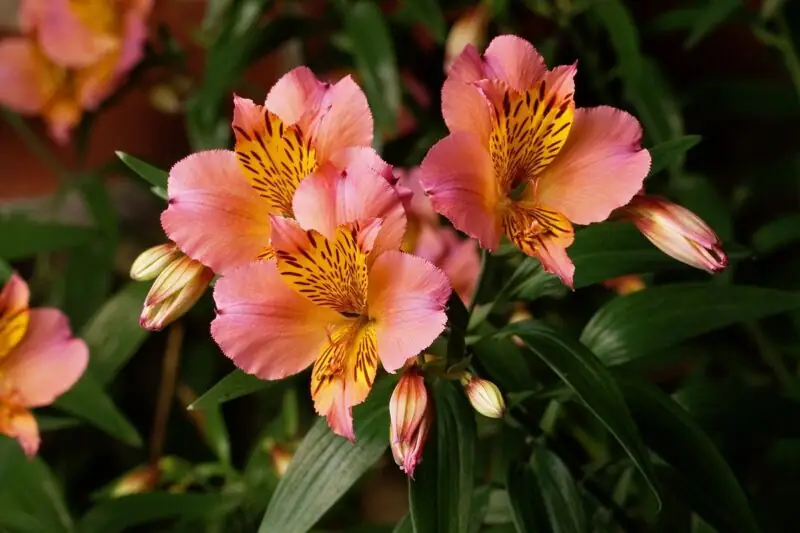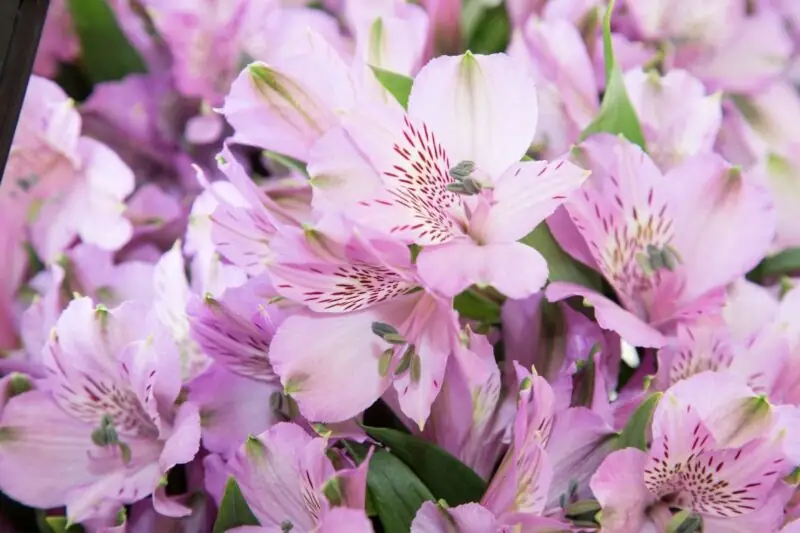Peruvian Lily Alstroemeria Flower: How to Grow and Care for This Plant Hybrid

What is Alstroemeria?
Welcome to the world of alstroemeria, folks! Our star today is the vibrant alstroemeria flower, a perennial crowd-pleaser. Also known as Peruvian Lilies, these flowers stand tall, reaching up to 28 inches tall, while their petals boast a variety of colors. Each petal comes with a unique set of speckles and streaks, giving the alstroemeria a character as distinctive as a fingerprint. Gazing at these radiant blooms, you can’t help but feel a sense of joy and warmth engulfing your heart. As cut flowers in a vase, they’re the perfect gift for any horticulturist and are sure to keep them happy.
Relation of Alstroemeria with the Lily Family
So, you’ve heard of alstroemeria being referred to as the Peruvian Lily, but are they actual lilies? Well, not quite. While they belong to the Alstroemeriaceae family and share some semblance with lilies—like the way their enchanting flowers bloom—they aren’t lilies. Picture them as the far-flung cousins who swoop in at family reunions, surprising everyone with their unique charm and vibrant personalities.
Alstroemeria’s Origin – The Peruvian Lily
Now let’s take a trip back in time and look at the history around the plant. Alstroemeria hails from and is native to South America. From there, these resilient flowers have journeyed far and wide, capturing hearts around the globe. Fondly known as the “Lily of the Incas”. The flower is named after the Swedish baron Claus von Alstromer. Talk about global recognition!
Types of Alstroemeria Flowers
Overview of Various Alstroemeria Types
Here’s where the magic truly unfolds. Alstroemeria is a flower that delights in diversity. From hybrids known for their striking, exhibition-worthy blooms, to the species types that carry a subtler, understated charm, there’s a wide array of alstroemeria types to explore and admire. From creamy yellow to dark red, these flowers bloom and charm people worldwide.
White Alstroemeria: Description and Significance
Among the color parade, the white alstroemeria emerges as a timeless beauty. Picture it as that elegant piece of jewelry that never goes out of style, always ready to add a dash of sophistication to any setting. Its gently speckled petals often play a starring role in flower arrangements, bringing a tranquil beauty that soothes the senses.
The Allure of Purple Alstroemeria
On the other end of the color spectrum, we have the audacious purple alstroemeria. Its striking purple blooms are unmissable, adding a vibrant burst of color that demands attention. With its magnetic appeal, it refuses to be a wallflower. And why should it?
How to Grow Alstroemeria: A Comprehensive Growing Guide
Ideal Conditions for Alstroemeria to Bloom
Growing these floral stars isn’t rocket science. Just remember a few basic rules. Alstroemerias are sun-loving creatures that also appreciate a bit of shade; think early summer. They’re best friends with well-drained soil, which helps them steer clear of any root rot drama. Regular hydration keeps them happy, but they’re not fans of waterlogged homes. One inch of water should be plenty.
The Role of Sunlight in Alstroemeria Growth
Sunlight plays a crucial role in the life of an alstroemeria. These flowers are like a solar-powered wonder—they need just the right amount of sun, not too little, not too much. Striking the perfect balance here will ensure they put on their best performance, resulting in an impressive display of blooms. Partial shade should be ideal.
Water Requirements for Alstroemeria
Hydration is key for these flowers. Alstroemerias prefer a consistent watering schedule that keeps the soil sufficiently moist but not waterlogged. Root rot isn’t part of any plant’s wishlist, so allow the soil to dry out slightly between waterings. They love their H2O, but they don’t want to swim in it! Let the soil breathe for the best results.
Alstroemeria and Temperature: The Ideal Climate
Some might think that as natives of South America, alstroemerias would only thrive in tropical climates. The reality is that these hardy plants are pretty adaptable when it comes to temperature. They can endure the chill of winter as well as they can bask in the warmth of summer, making them suitable for various climates. The secret to their success lies in the first two winters. A layer of mulch is highly recommended to ensure your alstroemerias survive these crucial years. It insulates the plants from harsh cold and intense frost. As long as you protect them from drastic temperature swings, they’ll continue to flourish, displaying their magnificent blooms season after season.
Soil and Fertilizer Best Suited for Alstroemeria
Just like us, plants need a balanced diet to ensure healthy growth and development. For alstroemerias, this balanced diet comes from the soil they’re planted in and the fertilizer they receive. First, the soil—well-drained soil is a non-negotiable factor. It prevents waterlogging and reduces the risk of root rot, creating an optimal environment for the plants to thrive.
Second, fertilizer—a regular dose of balanced fertilizer, preferably one with equal proportions of nitrogen, phosphorus, and potassium, can make a significant difference in your alstroemerias’ health. It’s akin to a nourishing meal for the plants. The plant grows well when it has the nutrients it needs to bloom brilliantly.
Alstroemeria Care Tips
Repotting Alstroemeria: A Fresh Start
Alstroemerias are not just aesthetically pleasing; they’re also low-maintenance, making them an excellent choice for both novice and experienced gardeners. One aspect of their care involves repotting, which is recommended every two to four years. This is because alstroemerias are vigorous growers that can form large colonies of new plants. Repotting gives them more room to grow, while also offering an excellent opportunity to divide the rhizomes and expand your collection of these captivating plants.
Tips to Propagate Alstroemeria
Propagation is another aspect of alstroemeria care that gardeners enjoy. Given that these flowers grow from tuberous roots, they can easily be propagated through division. This process involves separating a section of the plant, complete with roots, and planting it elsewhere. The result is new, independent plants that carry the same genetic material and, consequently, the same attractive characteristics as the parent plant. It’s like breathing new life into your garden, leading to an expanded display of blooms that continues to captivate with each passing season.
Preparing Alstroemeria for Winter
While alstroemerias are capable of withstanding winter, they do appreciate a little extra care during this cold season. Preparing your plants for winter, also known as overwintering, primarily involves allowing the foliage to die back naturally once fall arrives. This is followed by applying a layer of mulch over the base of the plants. This protective layer insulates the plants from the cold, ensuring they remain safe and snug throughout the winter. Once spring comes around, they’ll be rejuvenated and ready to regale your garden with their vibrant blooms once again.
Alstroemeria Pests and Diseases: Staying Vigilant

Identifying and Dealing with Common Pests in Alstroemeria
Unfortunately, this is a common problem in gardening. Even the most well-cared-for plants can fall prey to pests. In the case of alstroemerias, common culprits include aphids and spider mites. These tiny intruders can infest your plants, sucking the sap and causing damage. They’re a bit like uninvited guests who show up unannounced and overstay their welcome. But worry not; with regular inspections and prompt action, you can ensure these party crashers don’t wreak havoc. Keeping a keen eye out for any signs of infestation, such as discoloration or curling of the leaves, and addressing them promptly with appropriate pest control measures, will help maintain the health and vigor of your alstroemeria plants.
Battling Common Diseases in Alstroemeria
Much like their run-ins with pests, alstroemerias can occasionally encounter diseases as well. Gray mold and root rot are among the most common issues these plants may face. Both can be particularly troublesome if your alstroemerias are living in conditions with poor drainage or if their leaves and stems remain wet for extended periods. However, armed with knowledge and proactive care, you can prevent or promptly address these issues. Ensuring your plants have good drainage, avoiding overwatering, and allowing the foliage to dry before nighttime are a few ways to keep these diseases at bay.
Alstroemeria FAQs
One question that often pops up in the minds of gardening enthusiasts and flower lovers alike is whether alstroemeria is an annual or perennial plant. Well, let’s put this curiosity to rest. Alstroemeria is a perennial plant, which means it’s in it for the long haul. Unlike annuals that complete their life cycle in a single year, perennials live for more than two years. So, once you welcome alstroemerias into your garden, you can look forward to their enchanting beauty gracing your surroundings season after season!
Maintaining the appearance and health of your alstroemeria involves occasional grooming, which might lead you to wonder if cutting back the stems is a good idea. Interestingly, alstroemerias prefer a slightly different treatment. Instead of cutting the stems, it’s better to pull them from the base. This technique encourages the growth of new blooms while keeping the plant looking neat and tidy.
Alstroemeria’s charm is not just in its captivating beauty but also in its lasting power. Renowned for their long vase life, these flowers can keep your interiors looking vibrant and fresh for up to two weeks! This, combined with their wide spectrum of colors, makes them a popular choice for floral arrangements and bouquets. With proper care, which includes changing the water regularly and keeping them away from direct sunlight and ripening fruit, you can maximize its longevity.
When it comes to nurturing alstroemerias, the type of soil and fertilizer you use plays a significant role. These plants thrive best in well-drained soil, which ensures they have the right balance of moisture without running the risk of waterlogging. For fertilizer, a balanced mix applied during the growing season works wonders for these plants. T is mix should ideally contain equal parts of nitrogen, phosphorus, and potassium – a combination that promotes overall plant health, stimulating leaf, root, and bloom development.
If you’ve fallen in love with alstroemerias but are worried about space constraints or unfavorable ground soil, you’ll be pleased to know that these adaptable plants can indeed be grown in pots! Cultivating alstroemerias in containers not only allows you to enjoy their charm indoors but also adds a vibrant touch to your balconies or patios. Just ensure the pots have adequate drainage, and you’ll have a portable piece of the Andean landscape right in your home.
Conclusion
And so, our exploration of the alstroemeria flower comes full circle. From its origins in South America, this remarkable plant has traveled far and wide, capturing the hearts of flower enthusiasts around the globe. With its captivating blooms that paint a vibrant color palette across your garden, and its unique speckles and streaks that give each flower its distinctive charm, the alstroemeria is truly a sight to behold.